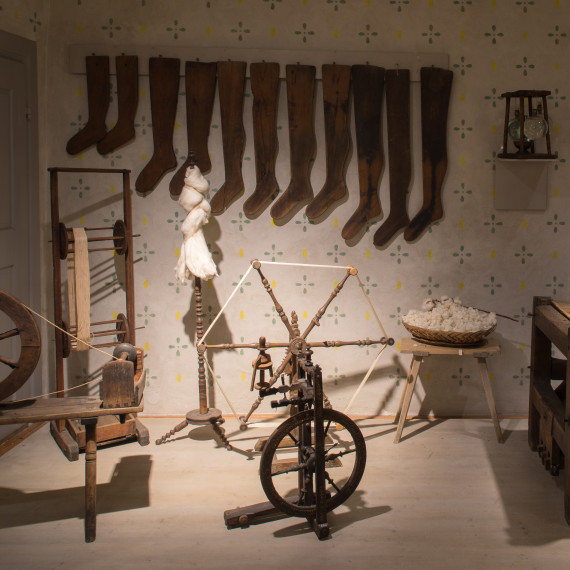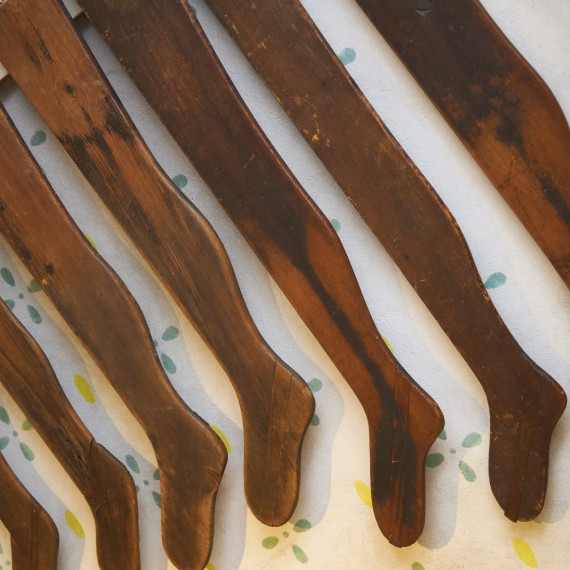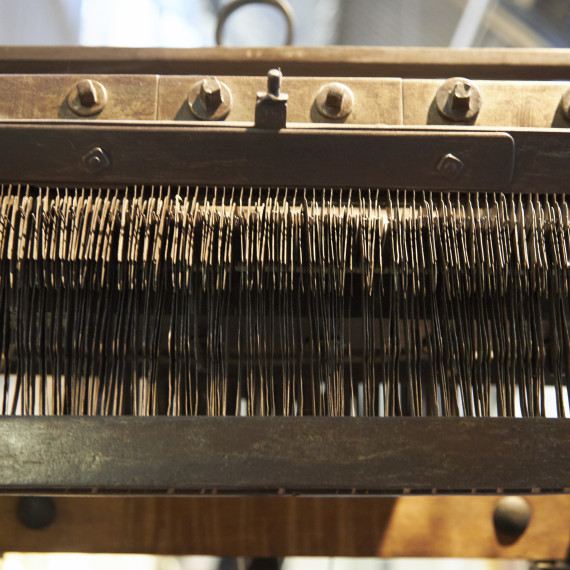The Hosier's Workshop
 Reconstruction of a hosier's workshop
Reconstruction of a hosier's workshop
The workshop's equipment includes a loom or ‘stocking frame’ called Rößchenstuhl ('little horse loom') featuring a second row of needles, three pounds of cotton, a treadle spinning wheel, several spinner's weasels, sock boards, and a water-filled glass balloon called Schusterkugel ('shoemaker's ball') used to amplify the light of a single candle or lamp.
The workshop
In the 18th century, small workshops dominated hosiery production. In 1798, with signs of a looming crisis for the craft becoming more frequent, more than half of all hosiers in Erlangen operated as 'sole masters', and almost a quarter had only one journeyman working with them.
Their workshops were located within domestic dwellings and their outbuildings. Given there were 450 master hosiers and 563 looms or 'stocking frames', on average one hosier was working in every second or third house – except for the town squares and main street, which were inhabited mainly by wealthy citizens.
As around four assistant labourers were required to operate each loom, hosiery production employed more than 2000 secondary workers – most of them women and, in some cases, children – who 'carded' (combed) and spun the cotton, sewed together the flat-knitted pieces, washed and pressed the stockings, or, as Blumennäherinnen ('flower stitchers'), added embellishments. Often, these tasks were also carried out in the hosier's workshop by his own wife and children. Conditions became especially cramped when the same room served as workshop and living area at the same time.
Apart from the hosiers themselves, a number of 'professionalists' also existed, who owned special equipment for 'dressing' the product, and who took care of the dyeing, fulling, and pressing of hosiery.
 Stocking molding boards
Stocking molding boards
Erlangen, 19th century
After the socks were sewn together, they were washed and put on shaped boards to dry.
The knitted stocking
In the 18th century, stockings were not just plain, utilitarian items. As long as knee-breeches remained in fashion, men showed off their legs – and therefore their stockings, too. Only when full-length trousers became widespread around 1820/30, men's stockings lost their significance. Until the appearance of shorter dresses, women wore stockings under their ankle-length skirts, knowing, however, that a good portion of them would often become visible.
Because they had stretch and thus fitted the leg most snugly, knitted stockings were most in demand. They were available mainly in wool, and later also in cotton, while fine silk stockings were expensive luxury items that almost exclusively sold among the aristocracy. Customer desires were matched by a diverse product range, which changed frequently towards the end of the 18th century. It included white as well as coloured, mottled, and striped stockings, as well as models embellished with embroidered flowers or decorative knit patterns. Suitable for winter was the 'castor stocking' made from combed yarn, which was heavily fulled or 'walked' after being sown together.
Erlangen mainly produced stockings for a broad customer base. At the end of the 18th century, the use of cotton prevailed, which had found its way into to the local industry around 1740. Silk stockings were only produced occasionally.
However, Erlangen stockings still weren't cheap, mass-produced items that everyone would be able to afford. In 1792, one pair of stockings cost on average half a guilder, which was more expensive even than a pair of Erlangen glacé gloves.
 Stocking frame
Stocking frame
Around 1700, the stocking frame was considered a technological masterpiece. This stocking frame is the oldest of the few examples surviving in Germany. It originates from the workshop of Erlangen's last hosier, and had been in use for around 200 years.
The stocking frame
The stocking frame was invented by English clergyman William Lee in 1589, arrived in France in 1608, and entered Germany with the Huguenots from 1686 onwards. Contemporary literature praises it as a 'masterpiece of inventiveness and wit, the most artful tool of all craftsmen and artists’.
Its most original version is the Rößchenstuhl ('little horse loom'), whereby Rößchen ('little horse') is the name for a small, wedge-shaped piece of steel that lifts each in a row of levers in turn to form a yarn loop on each needle, creating one knitting stitch at a time. These stocking frames consist of around 3500 components and were also used by the Erlangen hosiers. Producing this complicated and expensive device involved metalworkers and woodworkers specialising in knitting frames, as well as needlemakers.
The design of this knitting loom or 'frame' rests on the principle of looping a single, continuous thread into itself to form a row of knitting stitches. The actual tools involved are protruding hooked needles and suspended sinkers, which are set in motion individually by the interactions between the remaining mechanical parts. Based on this mechanism, nine rapidly interlocking working steps are required to produce each row of stitches.
Compared to hand knitting, stocking frames enabled significantly faster production speeds. A daily output of two pairs of stockings or four to six bonnets was considered average. However, this type of hosiery was not knitted 'in the round', so that the resulting flat pattern pieces had to be sewn up into the stockings and bonnets afterwards. By installing additional mechanisms, decorative knit patterns could also be produced from around 1750 onwards.
In the 19th century, the Rößchenstuhl was replaced by mechanically operated stocking frames.
 Detail of a stocking frame
Detail of a stocking frame
The hosiers' social situation
From its beginnings, the hosiery trade was shaped by the putting-out system. Very many of the hosiers worked at piece rates for capital-rich 'agents' or 'merchants'. These dependent master craftsmen ended up living in rather impoverished conditions as early as the 18th century. However, there was also a large group of 'masters on their own account', who distributed their wares themselves or had them sold on commission at trade fairs. They often employed one or two journeymen and, during the heyday of their craft, managed to earn an 'honest' livelihood, almost half of them even owning a house.
Following the French Revolutionary Wars beginning in 1792, the economic situation of the hosiers deteriorated further and further. This led to a lack of work, debt, and 'blatant abuse in the putting-out system'; during the Continental Blockade (1807 -1810), production had to be almost totally abandoned because of a lack of cotton. To support impoverished hosiers, a hosiery stockpile was set up by the Prussian government in 1804, but it had soon exhausted the funds set aside for it.
In the course of the remaining part of the 18th century, the unstoppable decline of this now backward industry led to a drop in the social status of the entire profession. Even government support interventions could not prevent mass poverty among outworkers and Strumpfer ('sockers').
Occupational health
In the medical literature of the late 18th century, 'consumption' was considered a typical occupational disease among hosiers. Its symptoms included chronic cough, purulent sputum or 'spitting blood', and could lead to 'hectic fever' and a gradual emaciation of the body. The records in death registers, which list Auszehrung (wasting) as the most common cause of death among hosiers, also lead to this conclusion. These symptoms point to tuberculosis, whose pathogen wasn't discovered until 1882.
The hosiers' susceptibility to chronic pulmonary conditions was a result of their harsh and unhealthy working and living conditions. Apart from the physically demanding and repetitive work at the stocking frame, the air in the workshops, which was polluted by cotton dust, was particularly harmful. Adding to this were the effects of material conditions characterised by poverty and, in times of crisis, existential threat: being forced to work through the night, lack of recreation, cramped living conditions, inadequate sanitation, and poor nutrition.
Another health complaint common among hosiers was chronic eye inflammation. This illness, too, had economic reasons, namely night-time work and saving on the use of artificial lighting.
At this time, unhealthy working conditions prevailed in many industries. In cotton printing, for example, workers handled toxic substances used as additives to dyes and mordants.
< Previous chapter | Next chapter >
